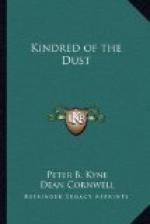* * * * *
In the southwestern corner of the state of Washington, nestled in the Bight of Tyee and straddling the Skookum River, lies the little sawmill town of Port Agnew. It is a community somewhat difficult to locate, for the Bight of Tyee is not of sufficient importance as a harbor to have won consideration by the cartographers of the Coast and Geodetic Survey, and Port Agnew is not quite forty years old. Consequently, it appears only on the very latest state maps and in the smallest possible type.
When Hector McKaye first gazed upon the bight, the transcontinental lines had not yet begun to consider the thrusting of their tentacles into southwestern Washington, and, with the exception of those regions where good harbors had partially solved the problem of transportation, timber in Washington was very cheap. Consequently, since Hector McKaye was one of those hardy men who never hesitate to take that which no man denies them, he reached forth and acquired timber.
A strip of land a quarter of a mile wide and fronting the beach was barren of commercial timber. As grazing-land, Hector McKaye was enabled to file on a full section of this, and, with its acquisition, he owned the key to the outlet. While “proving up” his claim, he operated a general store for trading with the Indians and trappers, and at this he prospered. From time to time he purchased timber-claims from the trappers as fast as they “proved up,” paying for these stumpage-prices varying from twenty-five to fifty cents per thousand.
On his frequent trips to the outer world, McKaye extolled the opportunities for acquiring good timber-claims down on the Skookum; he advertised them in letters and in discreet interviews with the editors of little newspapers in the sawmill towns on Puget Sound and Grays Harhor; he let it be known that an honest fellow could secure credit for a winter’s provisions from him, and pay for it with pelts in the spring.
The influx of homesteaders increased—single men, for the most part, and poor—men who labored six months of the year elsewhere and lived the remaining six months in rude log huts on their claims down on the Skookum. And when the requirements of the homestead laws had been complied with and a patent to their quarter-section obtained from the Land Office in Washington, the homesteaders were ready to sell and move on to other and greener pastures. So they sold to the only possible purchaser, Hector McKaye, and departed, quite satisfied with a profit which they flattered themselves had been the result of their own prudence and foresight.
Thus, in the course of ten years, Hector McKaye’ acquired ten thousand acres of splendid Douglas fir and white cedar. But he had not been successful in acquiring claims along the south bank of the Skookum. For some mysterious reason, he soon found claims on the north bank cheaper and easier to secure, albeit the timber showed no variance in quantity or quality. Discreet investigations brought to light the fact that he had a competitor—one Martin Darrow, who dwelt in St. Paul, Minnesota. To St. Paul, therefore, journeyed Hector McKaye, and sought an audience with Martin Darrow.




